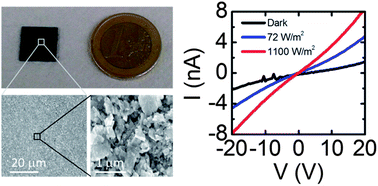Photoconductivity of solution-processed MoS2 films
Abstract
Solution-exfoliated MoS2 nano-platelets were formed into thin films by deposition onto a water surface followed by transfer to indium tin oxide coated glass. After drying, a gold electrode was evaporated on top to give a sandwich structure with quasi-Ohmic contacts. Illumination of this device with broadband light of ∼1 kW m−2 intensity gave a fourfold increase in conductivity. The photocurrent increased sub-linearly with intensity and exponentially with time indicating the presence of traps. The photo-responsively at low intensity was ∼10−4 A per W at 15 V. This work demonstrates the potential for liquid-exfoliated, inorganic nanosheets to be fabricated into low-cost optoelectronic devices.


 Please wait while we load your content...
Please wait while we load your content...